Rhetorical Persuasive Essay: Benefits of Telecommuting for Employers
VerifiedAdded on 2022/09/09
|7
|1472
|71
Essay
AI Summary
This essay presents a persuasive argument for why employers should allow employees to telecommute at least one day a week. It highlights the numerous benefits of telecommuting, including increased employee productivity, reduced operational costs, and improved employee well-being. The essay draws on research and real-world examples to demonstrate how remote work arrangements can lead to greater efficiency, flexibility, and employee satisfaction. It also addresses potential drawbacks and suggests strategies for successful implementation, emphasizing the importance of a well-structured plan. The essay concludes by reinforcing the value of telecommuting as a tool for enhancing both employee and organizational success, and its positive impact on the environment. The essay aims to convince employers to adopt telecommuting policies to improve their business outcomes.
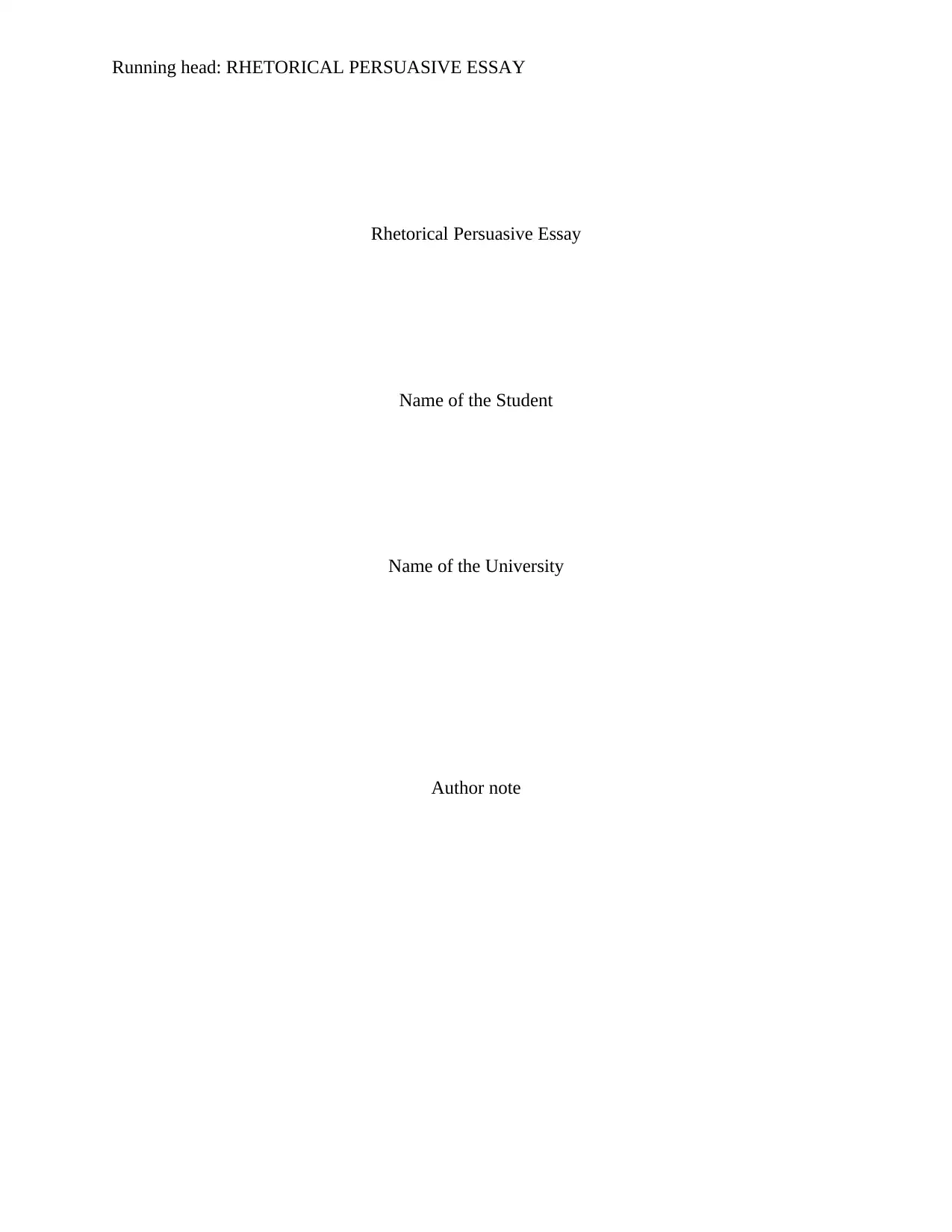
Running head: RHETORICAL PERSUASIVE ESSAY
Rhetorical Persuasive Essay
Name of the Student
Name of the University
Author note
Rhetorical Persuasive Essay
Name of the Student
Name of the University
Author note
Paraphrase This Document
Need a fresh take? Get an instant paraphrase of this document with our AI Paraphraser
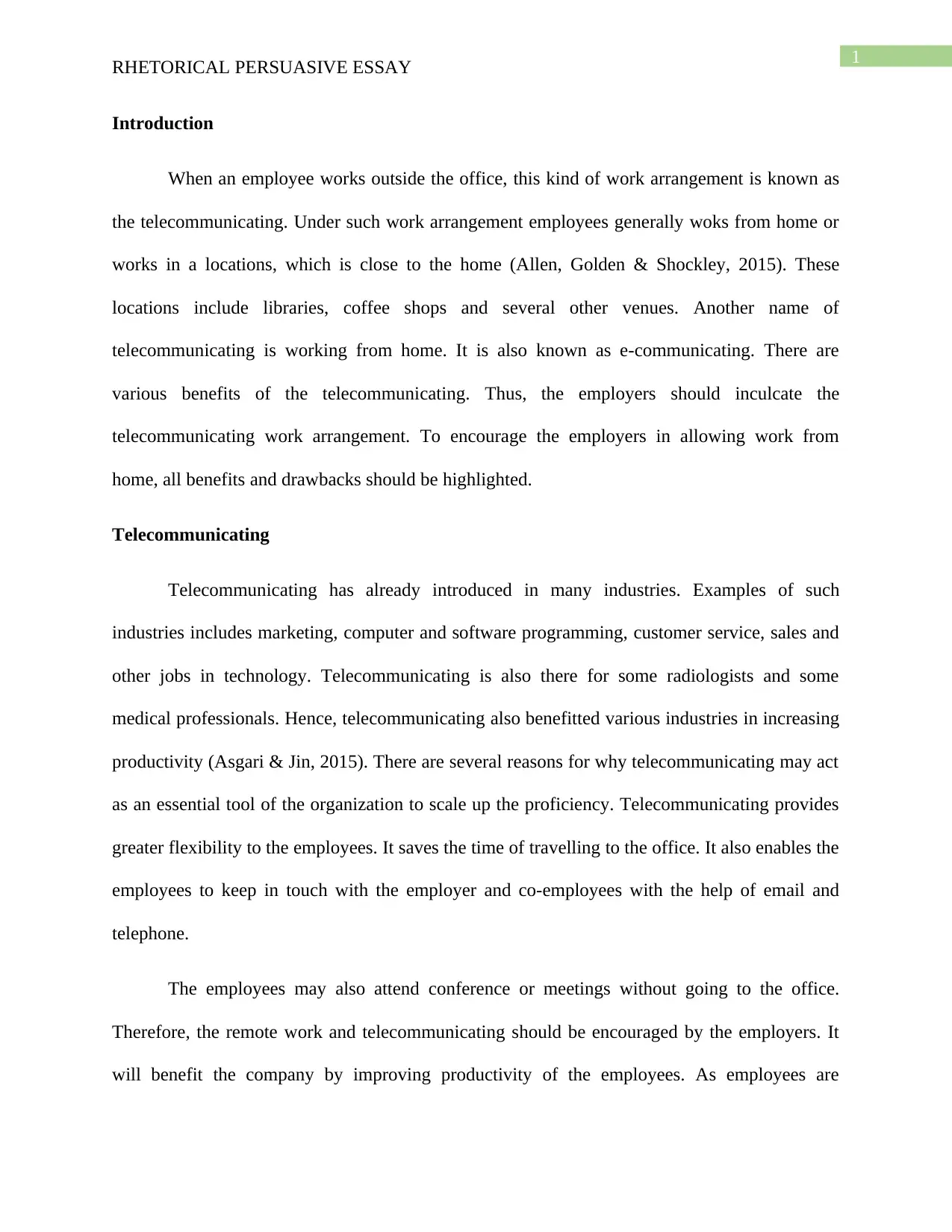
1
RHETORICAL PERSUASIVE ESSAY
Introduction
When an employee works outside the office, this kind of work arrangement is known as
the telecommunicating. Under such work arrangement employees generally woks from home or
works in a locations, which is close to the home (Allen, Golden & Shockley, 2015). These
locations include libraries, coffee shops and several other venues. Another name of
telecommunicating is working from home. It is also known as e-communicating. There are
various benefits of the telecommunicating. Thus, the employers should inculcate the
telecommunicating work arrangement. To encourage the employers in allowing work from
home, all benefits and drawbacks should be highlighted.
Telecommunicating
Telecommunicating has already introduced in many industries. Examples of such
industries includes marketing, computer and software programming, customer service, sales and
other jobs in technology. Telecommunicating is also there for some radiologists and some
medical professionals. Hence, telecommunicating also benefitted various industries in increasing
productivity (Asgari & Jin, 2015). There are several reasons for why telecommunicating may act
as an essential tool of the organization to scale up the proficiency. Telecommunicating provides
greater flexibility to the employees. It saves the time of travelling to the office. It also enables the
employees to keep in touch with the employer and co-employees with the help of email and
telephone.
The employees may also attend conference or meetings without going to the office.
Therefore, the remote work and telecommunicating should be encouraged by the employers. It
will benefit the company by improving productivity of the employees. As employees are
RHETORICAL PERSUASIVE ESSAY
Introduction
When an employee works outside the office, this kind of work arrangement is known as
the telecommunicating. Under such work arrangement employees generally woks from home or
works in a locations, which is close to the home (Allen, Golden & Shockley, 2015). These
locations include libraries, coffee shops and several other venues. Another name of
telecommunicating is working from home. It is also known as e-communicating. There are
various benefits of the telecommunicating. Thus, the employers should inculcate the
telecommunicating work arrangement. To encourage the employers in allowing work from
home, all benefits and drawbacks should be highlighted.
Telecommunicating
Telecommunicating has already introduced in many industries. Examples of such
industries includes marketing, computer and software programming, customer service, sales and
other jobs in technology. Telecommunicating is also there for some radiologists and some
medical professionals. Hence, telecommunicating also benefitted various industries in increasing
productivity (Asgari & Jin, 2015). There are several reasons for why telecommunicating may act
as an essential tool of the organization to scale up the proficiency. Telecommunicating provides
greater flexibility to the employees. It saves the time of travelling to the office. It also enables the
employees to keep in touch with the employer and co-employees with the help of email and
telephone.
The employees may also attend conference or meetings without going to the office.
Therefore, the remote work and telecommunicating should be encouraged by the employers. It
will benefit the company by improving productivity of the employees. As employees are
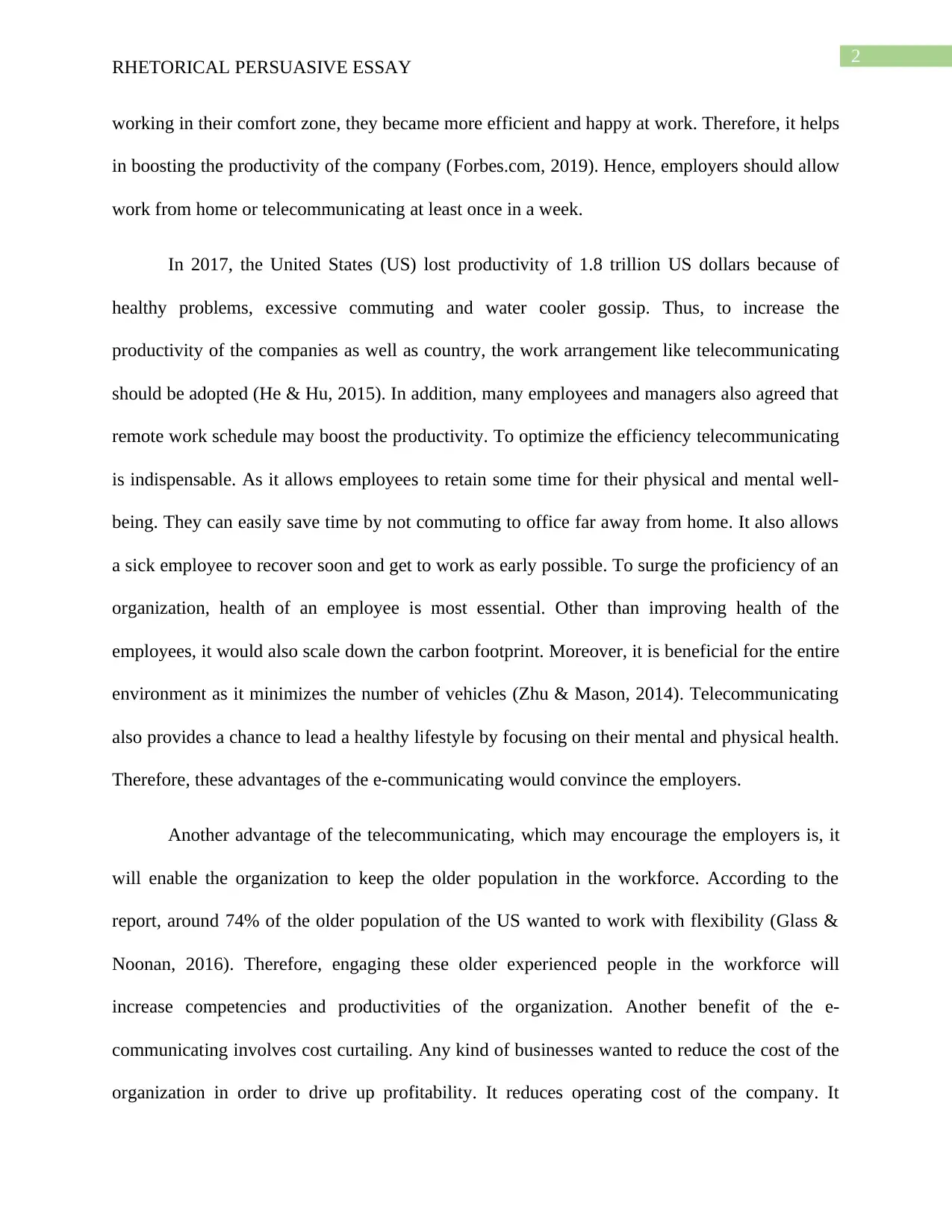
2
RHETORICAL PERSUASIVE ESSAY
working in their comfort zone, they became more efficient and happy at work. Therefore, it helps
in boosting the productivity of the company (Forbes.com, 2019). Hence, employers should allow
work from home or telecommunicating at least once in a week.
In 2017, the United States (US) lost productivity of 1.8 trillion US dollars because of
healthy problems, excessive commuting and water cooler gossip. Thus, to increase the
productivity of the companies as well as country, the work arrangement like telecommunicating
should be adopted (He & Hu, 2015). In addition, many employees and managers also agreed that
remote work schedule may boost the productivity. To optimize the efficiency telecommunicating
is indispensable. As it allows employees to retain some time for their physical and mental well-
being. They can easily save time by not commuting to office far away from home. It also allows
a sick employee to recover soon and get to work as early possible. To surge the proficiency of an
organization, health of an employee is most essential. Other than improving health of the
employees, it would also scale down the carbon footprint. Moreover, it is beneficial for the entire
environment as it minimizes the number of vehicles (Zhu & Mason, 2014). Telecommunicating
also provides a chance to lead a healthy lifestyle by focusing on their mental and physical health.
Therefore, these advantages of the e-communicating would convince the employers.
Another advantage of the telecommunicating, which may encourage the employers is, it
will enable the organization to keep the older population in the workforce. According to the
report, around 74% of the older population of the US wanted to work with flexibility (Glass &
Noonan, 2016). Therefore, engaging these older experienced people in the workforce will
increase competencies and productivities of the organization. Another benefit of the e-
communicating involves cost curtailing. Any kind of businesses wanted to reduce the cost of the
organization in order to drive up profitability. It reduces operating cost of the company. It
RHETORICAL PERSUASIVE ESSAY
working in their comfort zone, they became more efficient and happy at work. Therefore, it helps
in boosting the productivity of the company (Forbes.com, 2019). Hence, employers should allow
work from home or telecommunicating at least once in a week.
In 2017, the United States (US) lost productivity of 1.8 trillion US dollars because of
healthy problems, excessive commuting and water cooler gossip. Thus, to increase the
productivity of the companies as well as country, the work arrangement like telecommunicating
should be adopted (He & Hu, 2015). In addition, many employees and managers also agreed that
remote work schedule may boost the productivity. To optimize the efficiency telecommunicating
is indispensable. As it allows employees to retain some time for their physical and mental well-
being. They can easily save time by not commuting to office far away from home. It also allows
a sick employee to recover soon and get to work as early possible. To surge the proficiency of an
organization, health of an employee is most essential. Other than improving health of the
employees, it would also scale down the carbon footprint. Moreover, it is beneficial for the entire
environment as it minimizes the number of vehicles (Zhu & Mason, 2014). Telecommunicating
also provides a chance to lead a healthy lifestyle by focusing on their mental and physical health.
Therefore, these advantages of the e-communicating would convince the employers.
Another advantage of the telecommunicating, which may encourage the employers is, it
will enable the organization to keep the older population in the workforce. According to the
report, around 74% of the older population of the US wanted to work with flexibility (Glass &
Noonan, 2016). Therefore, engaging these older experienced people in the workforce will
increase competencies and productivities of the organization. Another benefit of the e-
communicating involves cost curtailing. Any kind of businesses wanted to reduce the cost of the
organization in order to drive up profitability. It reduces operating cost of the company. It
⊘ This is a preview!⊘
Do you want full access?
Subscribe today to unlock all pages.

Trusted by 1+ million students worldwide
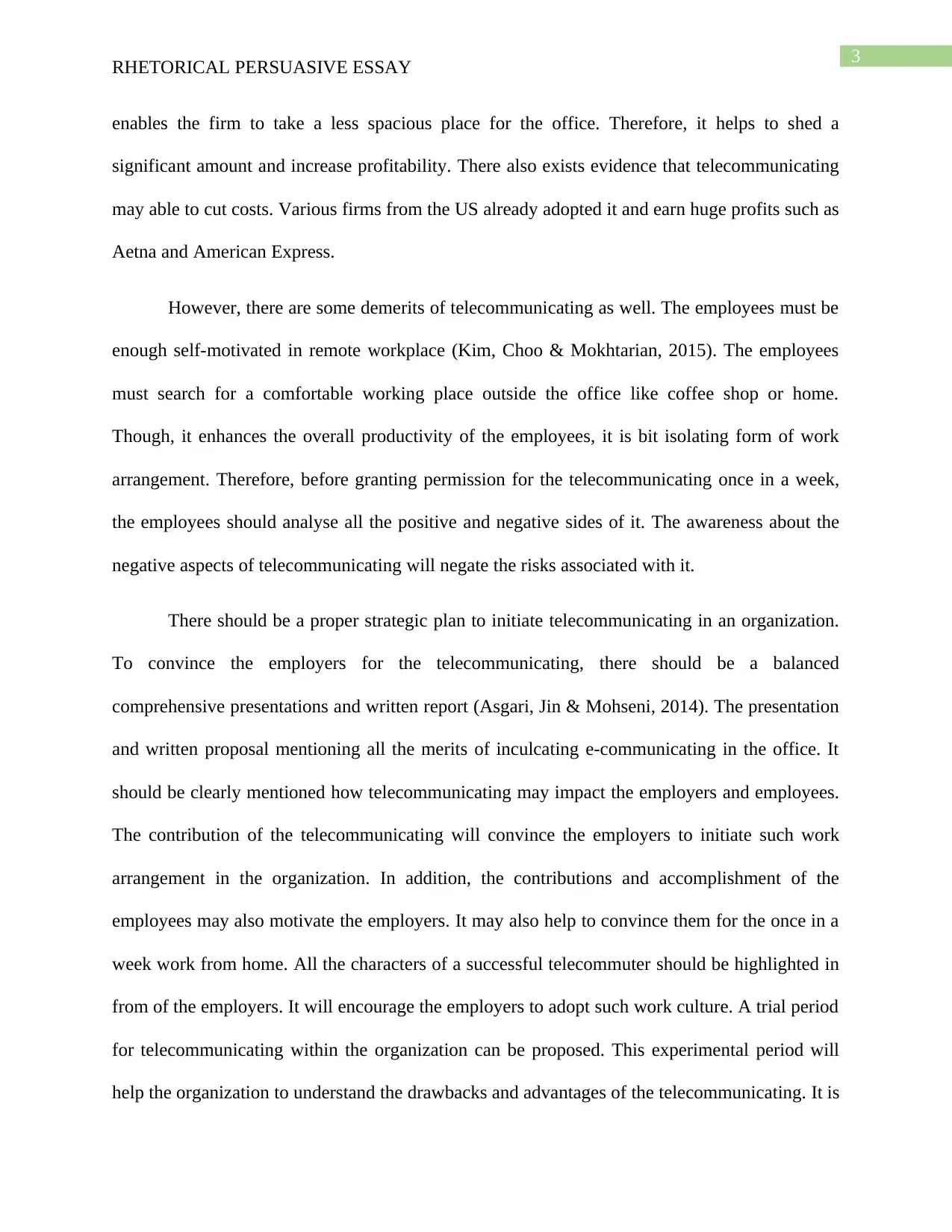
3
RHETORICAL PERSUASIVE ESSAY
enables the firm to take a less spacious place for the office. Therefore, it helps to shed a
significant amount and increase profitability. There also exists evidence that telecommunicating
may able to cut costs. Various firms from the US already adopted it and earn huge profits such as
Aetna and American Express.
However, there are some demerits of telecommunicating as well. The employees must be
enough self-motivated in remote workplace (Kim, Choo & Mokhtarian, 2015). The employees
must search for a comfortable working place outside the office like coffee shop or home.
Though, it enhances the overall productivity of the employees, it is bit isolating form of work
arrangement. Therefore, before granting permission for the telecommunicating once in a week,
the employees should analyse all the positive and negative sides of it. The awareness about the
negative aspects of telecommunicating will negate the risks associated with it.
There should be a proper strategic plan to initiate telecommunicating in an organization.
To convince the employers for the telecommunicating, there should be a balanced
comprehensive presentations and written report (Asgari, Jin & Mohseni, 2014). The presentation
and written proposal mentioning all the merits of inculcating e-communicating in the office. It
should be clearly mentioned how telecommunicating may impact the employers and employees.
The contribution of the telecommunicating will convince the employers to initiate such work
arrangement in the organization. In addition, the contributions and accomplishment of the
employees may also motivate the employers. It may also help to convince them for the once in a
week work from home. All the characters of a successful telecommuter should be highlighted in
from of the employers. It will encourage the employers to adopt such work culture. A trial period
for telecommunicating within the organization can be proposed. This experimental period will
help the organization to understand the drawbacks and advantages of the telecommunicating. It is
RHETORICAL PERSUASIVE ESSAY
enables the firm to take a less spacious place for the office. Therefore, it helps to shed a
significant amount and increase profitability. There also exists evidence that telecommunicating
may able to cut costs. Various firms from the US already adopted it and earn huge profits such as
Aetna and American Express.
However, there are some demerits of telecommunicating as well. The employees must be
enough self-motivated in remote workplace (Kim, Choo & Mokhtarian, 2015). The employees
must search for a comfortable working place outside the office like coffee shop or home.
Though, it enhances the overall productivity of the employees, it is bit isolating form of work
arrangement. Therefore, before granting permission for the telecommunicating once in a week,
the employees should analyse all the positive and negative sides of it. The awareness about the
negative aspects of telecommunicating will negate the risks associated with it.
There should be a proper strategic plan to initiate telecommunicating in an organization.
To convince the employers for the telecommunicating, there should be a balanced
comprehensive presentations and written report (Asgari, Jin & Mohseni, 2014). The presentation
and written proposal mentioning all the merits of inculcating e-communicating in the office. It
should be clearly mentioned how telecommunicating may impact the employers and employees.
The contribution of the telecommunicating will convince the employers to initiate such work
arrangement in the organization. In addition, the contributions and accomplishment of the
employees may also motivate the employers. It may also help to convince them for the once in a
week work from home. All the characters of a successful telecommuter should be highlighted in
from of the employers. It will encourage the employers to adopt such work culture. A trial period
for telecommunicating within the organization can be proposed. This experimental period will
help the organization to understand the drawbacks and advantages of the telecommunicating. It is
Paraphrase This Document
Need a fresh take? Get an instant paraphrase of this document with our AI Paraphraser
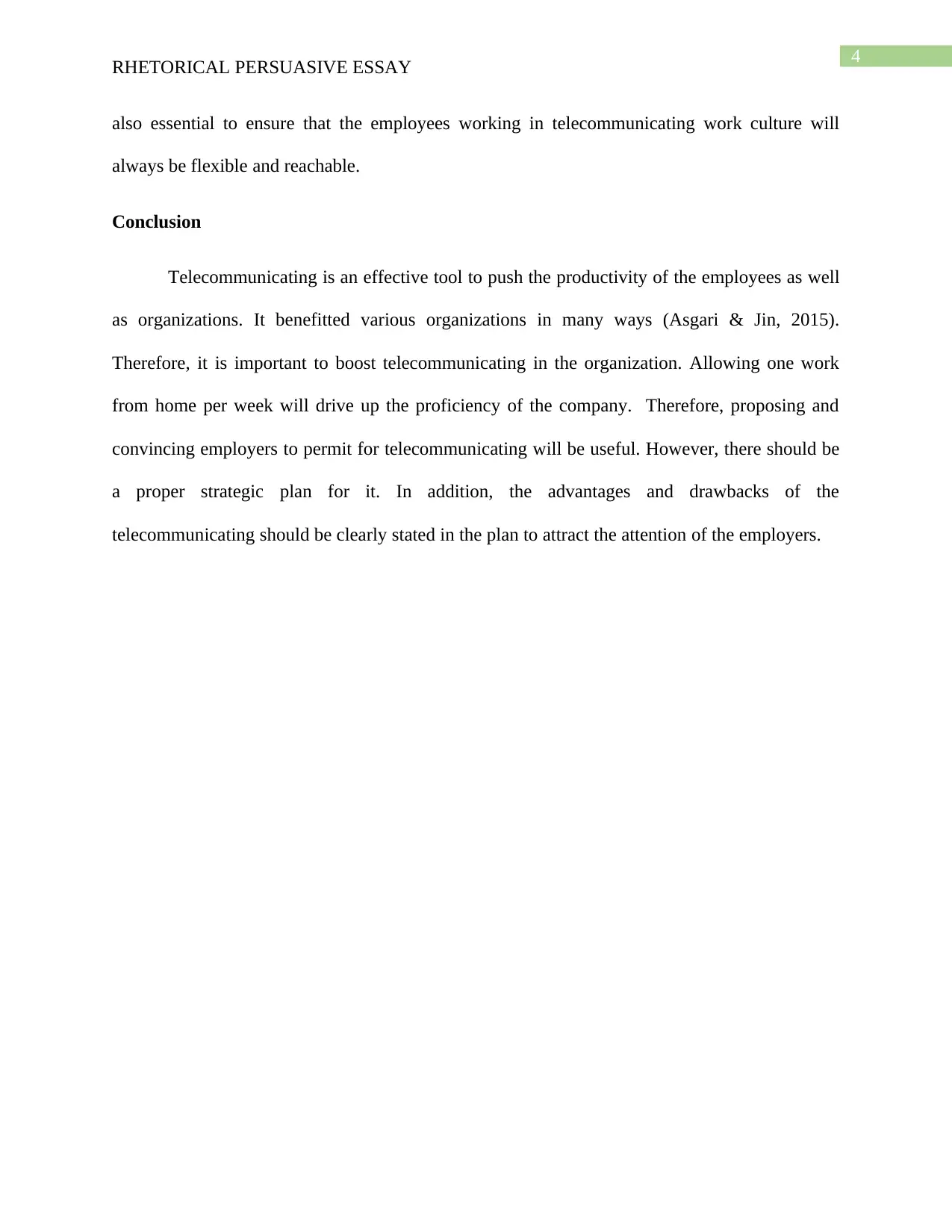
4
RHETORICAL PERSUASIVE ESSAY
also essential to ensure that the employees working in telecommunicating work culture will
always be flexible and reachable.
Conclusion
Telecommunicating is an effective tool to push the productivity of the employees as well
as organizations. It benefitted various organizations in many ways (Asgari & Jin, 2015).
Therefore, it is important to boost telecommunicating in the organization. Allowing one work
from home per week will drive up the proficiency of the company. Therefore, proposing and
convincing employers to permit for telecommunicating will be useful. However, there should be
a proper strategic plan for it. In addition, the advantages and drawbacks of the
telecommunicating should be clearly stated in the plan to attract the attention of the employers.
RHETORICAL PERSUASIVE ESSAY
also essential to ensure that the employees working in telecommunicating work culture will
always be flexible and reachable.
Conclusion
Telecommunicating is an effective tool to push the productivity of the employees as well
as organizations. It benefitted various organizations in many ways (Asgari & Jin, 2015).
Therefore, it is important to boost telecommunicating in the organization. Allowing one work
from home per week will drive up the proficiency of the company. Therefore, proposing and
convincing employers to permit for telecommunicating will be useful. However, there should be
a proper strategic plan for it. In addition, the advantages and drawbacks of the
telecommunicating should be clearly stated in the plan to attract the attention of the employers.
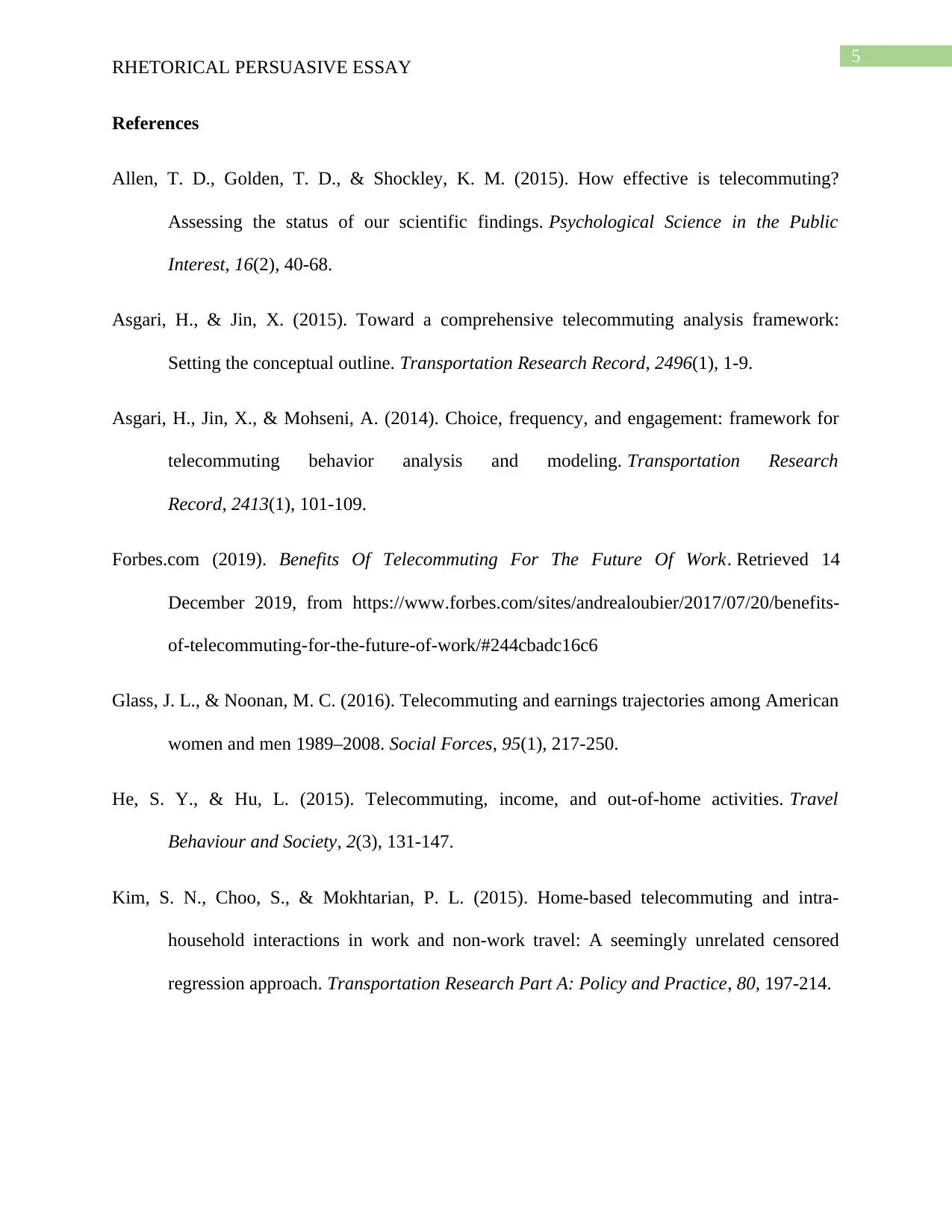
5
RHETORICAL PERSUASIVE ESSAY
References
Allen, T. D., Golden, T. D., & Shockley, K. M. (2015). How effective is telecommuting?
Assessing the status of our scientific findings. Psychological Science in the Public
Interest, 16(2), 40-68.
Asgari, H., & Jin, X. (2015). Toward a comprehensive telecommuting analysis framework:
Setting the conceptual outline. Transportation Research Record, 2496(1), 1-9.
Asgari, H., Jin, X., & Mohseni, A. (2014). Choice, frequency, and engagement: framework for
telecommuting behavior analysis and modeling. Transportation Research
Record, 2413(1), 101-109.
Forbes.com (2019). Benefits Of Telecommuting For The Future Of Work. Retrieved 14
December 2019, from https://www.forbes.com/sites/andrealoubier/2017/07/20/benefits-
of-telecommuting-for-the-future-of-work/#244cbadc16c6
Glass, J. L., & Noonan, M. C. (2016). Telecommuting and earnings trajectories among American
women and men 1989–2008. Social Forces, 95(1), 217-250.
He, S. Y., & Hu, L. (2015). Telecommuting, income, and out-of-home activities. Travel
Behaviour and Society, 2(3), 131-147.
Kim, S. N., Choo, S., & Mokhtarian, P. L. (2015). Home-based telecommuting and intra-
household interactions in work and non-work travel: A seemingly unrelated censored
regression approach. Transportation Research Part A: Policy and Practice, 80, 197-214.
RHETORICAL PERSUASIVE ESSAY
References
Allen, T. D., Golden, T. D., & Shockley, K. M. (2015). How effective is telecommuting?
Assessing the status of our scientific findings. Psychological Science in the Public
Interest, 16(2), 40-68.
Asgari, H., & Jin, X. (2015). Toward a comprehensive telecommuting analysis framework:
Setting the conceptual outline. Transportation Research Record, 2496(1), 1-9.
Asgari, H., Jin, X., & Mohseni, A. (2014). Choice, frequency, and engagement: framework for
telecommuting behavior analysis and modeling. Transportation Research
Record, 2413(1), 101-109.
Forbes.com (2019). Benefits Of Telecommuting For The Future Of Work. Retrieved 14
December 2019, from https://www.forbes.com/sites/andrealoubier/2017/07/20/benefits-
of-telecommuting-for-the-future-of-work/#244cbadc16c6
Glass, J. L., & Noonan, M. C. (2016). Telecommuting and earnings trajectories among American
women and men 1989–2008. Social Forces, 95(1), 217-250.
He, S. Y., & Hu, L. (2015). Telecommuting, income, and out-of-home activities. Travel
Behaviour and Society, 2(3), 131-147.
Kim, S. N., Choo, S., & Mokhtarian, P. L. (2015). Home-based telecommuting and intra-
household interactions in work and non-work travel: A seemingly unrelated censored
regression approach. Transportation Research Part A: Policy and Practice, 80, 197-214.
⊘ This is a preview!⊘
Do you want full access?
Subscribe today to unlock all pages.

Trusted by 1+ million students worldwide
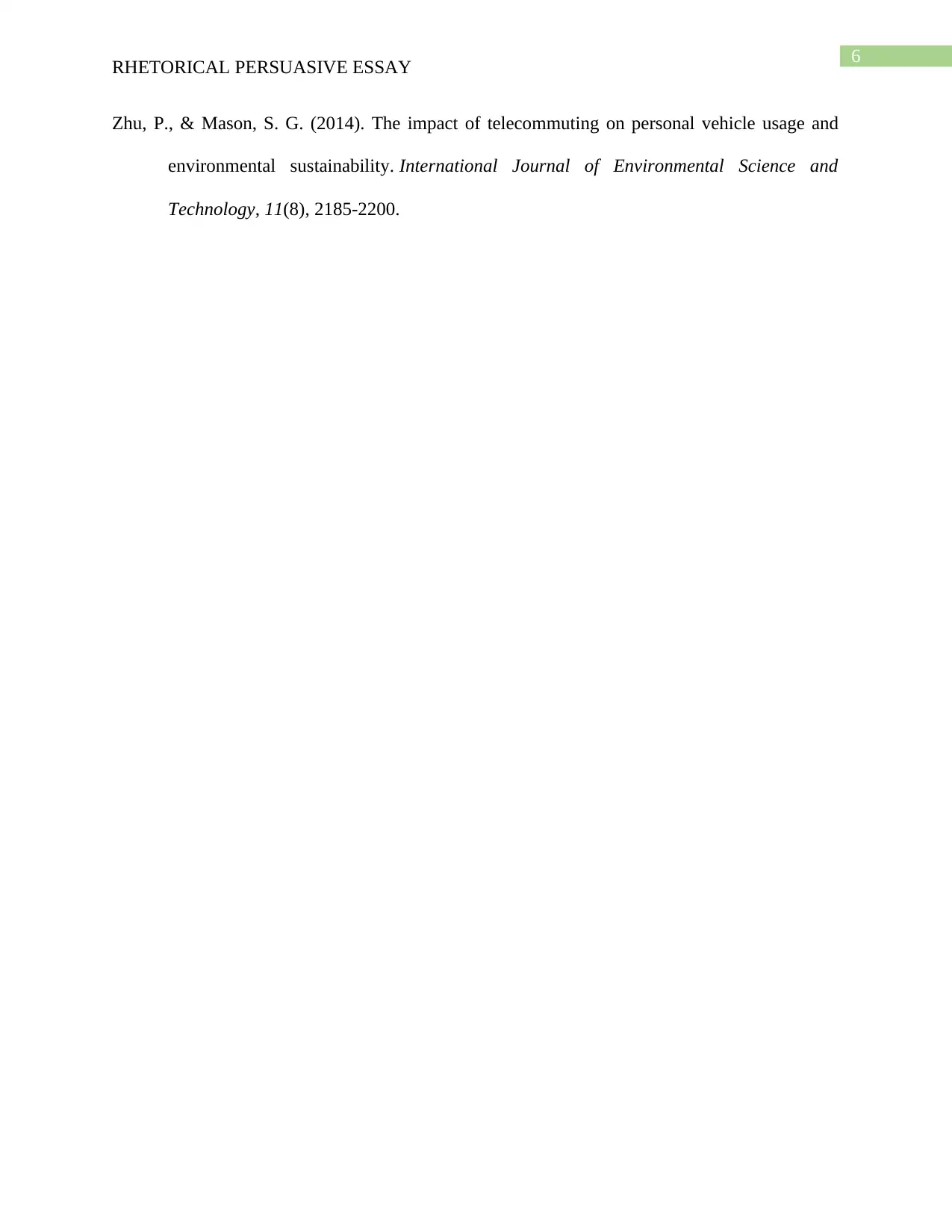
6
RHETORICAL PERSUASIVE ESSAY
Zhu, P., & Mason, S. G. (2014). The impact of telecommuting on personal vehicle usage and
environmental sustainability. International Journal of Environmental Science and
Technology, 11(8), 2185-2200.
RHETORICAL PERSUASIVE ESSAY
Zhu, P., & Mason, S. G. (2014). The impact of telecommuting on personal vehicle usage and
environmental sustainability. International Journal of Environmental Science and
Technology, 11(8), 2185-2200.
1 out of 7
Related Documents
Your All-in-One AI-Powered Toolkit for Academic Success.
+13062052269
info@desklib.com
Available 24*7 on WhatsApp / Email
![[object Object]](/_next/static/media/star-bottom.7253800d.svg)
Unlock your academic potential
Copyright © 2020–2025 A2Z Services. All Rights Reserved. Developed and managed by ZUCOL.





